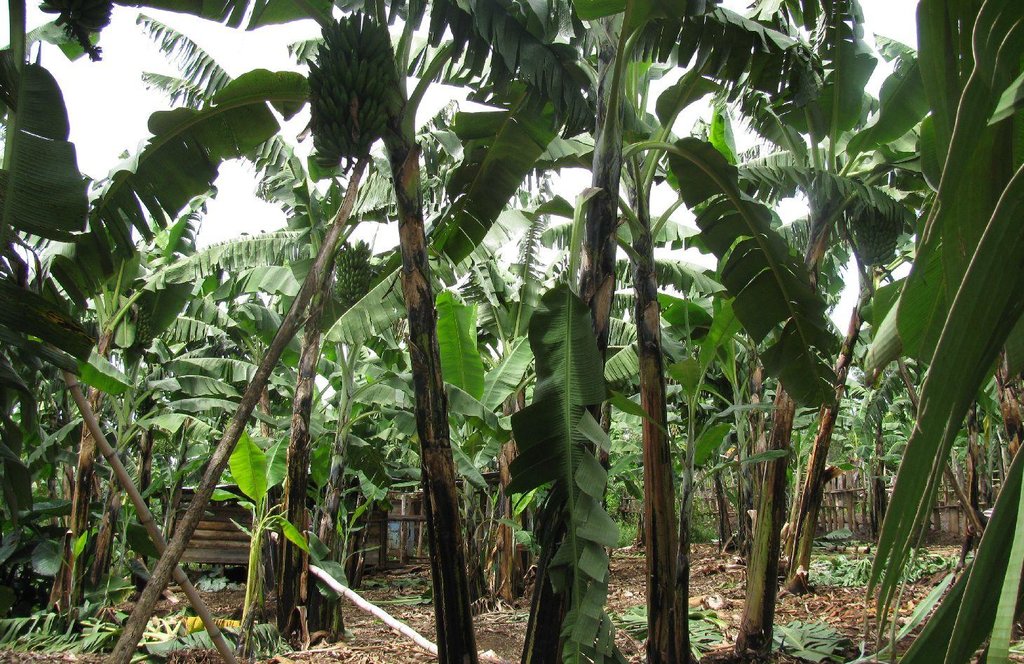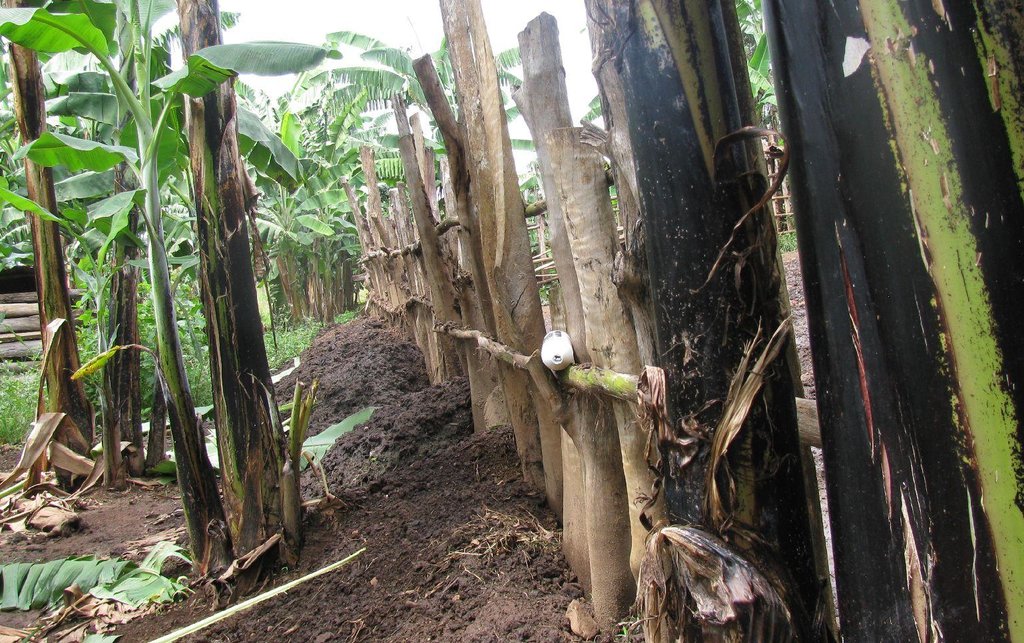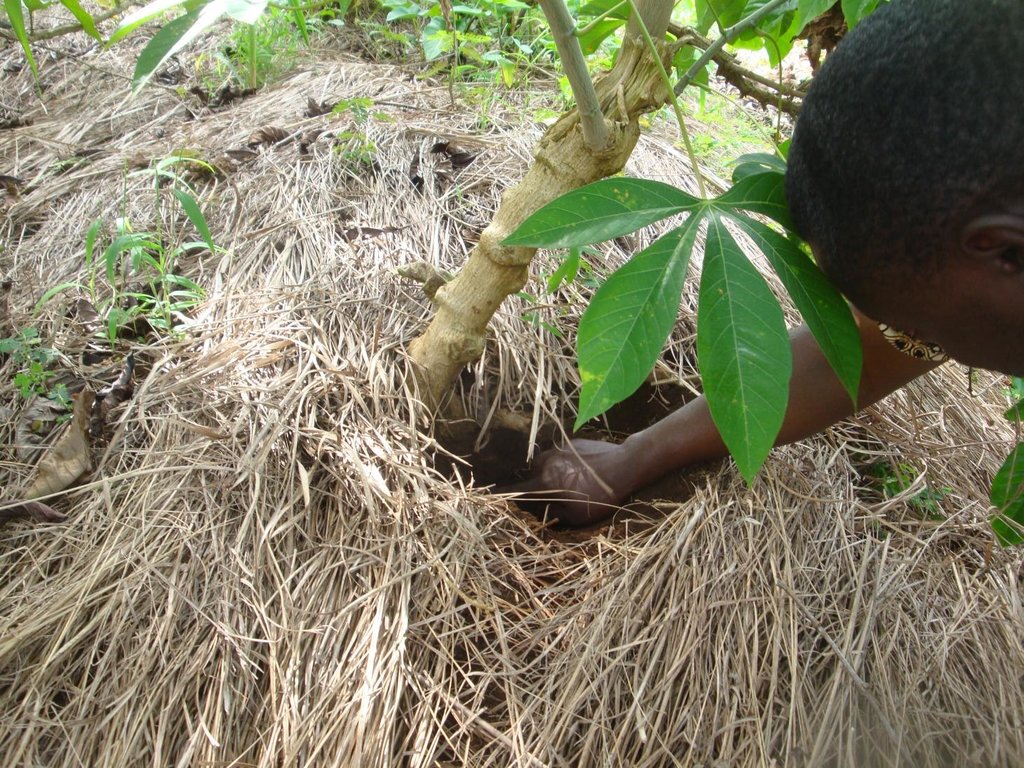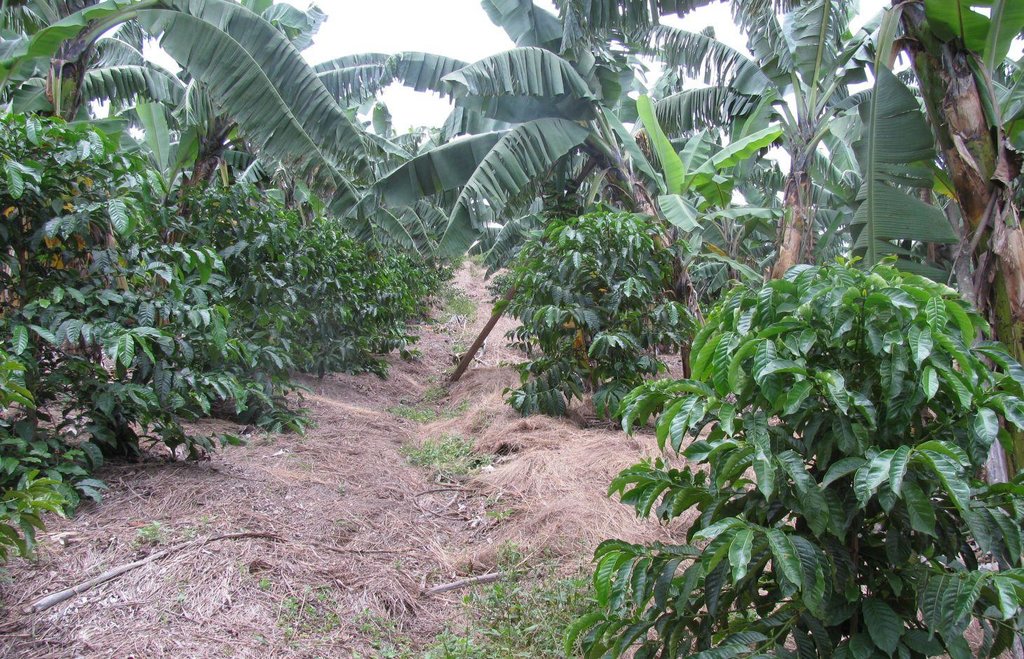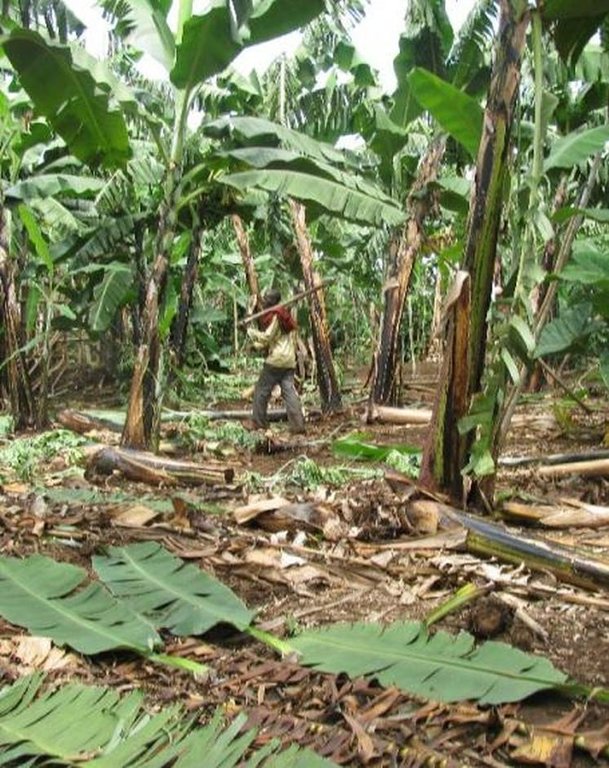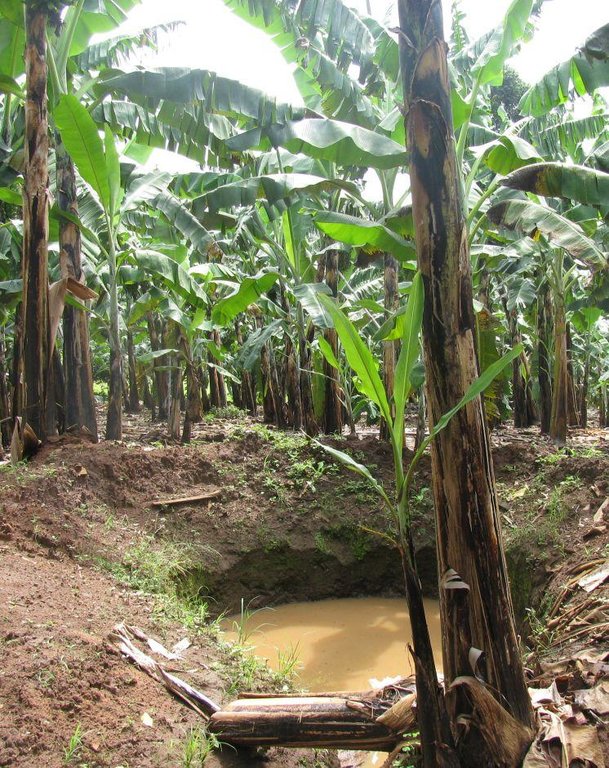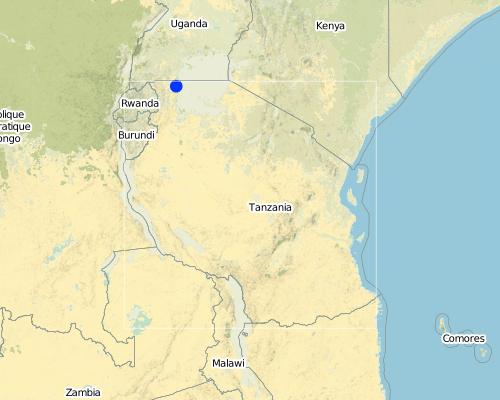Improved Kibanja cropping system [تنزانيا، جمهورية تنزانيا المتحدة]
- تاريخ الإنشاء:
- تحديث:
- جامع المعلومات: Jasson Rwazo
- المحرر: –
- المُراجع: David Streiff
Ekibanja ekiine emikolele emirungi (Haya/Nyambo)
technologies_1183 - تنزانيا، جمهورية تنزانيا المتحدة
عرض الأقسام
توسيع الكل طي الكل1. معلومات عامة
1.2 تفاصيل الاتصال بالأشخاص الرئيسيين لمصدر المعلومات والمؤسسات المشاركة في تقييم وتوثيق التقنية
Government:
متخصص في الإدارة المستدامة للأراضي:
Government:
Makung'uto Iddi
Missenyi District Council
تنزانيا، جمهورية تنزانيا المتحدة
Government:
Kagaruki Anna Grace
Missenyi District Council
تنزانيا، جمهورية تنزانيا المتحدة
Government:
Subira John
Missenyi District Council
تنزانيا، جمهورية تنزانيا المتحدة
متخصص في الإدارة المستدامة للأراضي:
Kaihura Fidelis
+255 754273849
Fidelis.kaihura@fao.org
Kagera TAMP
P.O.Box 127 Bukoba
تنزانيا، جمهورية تنزانيا المتحدة
Government:
Kitundu Elizabeth
Missenyi District Council
P.O.BOX 38 Missenyi
تنزانيا، جمهورية تنزانيا المتحدة
اسم المشروع الذي سهّل توثيق/تقييم التقنية (إذا كان ذلك على صلة)
The Transboundary Agro-ecosystem Management Project for the Kagera River Basin (GEF-FAO / Kagera TAMP )اسم المؤسسة (المؤسسات) التي سهلت توثيق/تقييم التقنية (إذا كان ذلك على صلة)
Food and Agriculture Organization of the United Nations (FAO) - إيطاليااسم المؤسسة (المؤسسات) التي سهلت توثيق/تقييم التقنية (إذا كان ذلك على صلة)
Missenyi District Council (Missenyi District Council) - تنزانيا، جمهورية تنزانيا المتحدة1.3 الشروط المتعلقة باستخدام البيانات الموثقة من خلال WOCAT
متى تم تجميع البيانات (ميدانيا)؟:
11/07/2012
يوافق جامع المعلومات والشخص (لاشخاص) الرئيسي لمصدر المعلومات على الشروط المتعلقة باستخدام البيانات الموثقة من خلال WOCAT:
نعم
1.5 الإشارة إلى الاستبيان (الاستبيانات) حول مناهج الإدارة المستدامة للأراضي
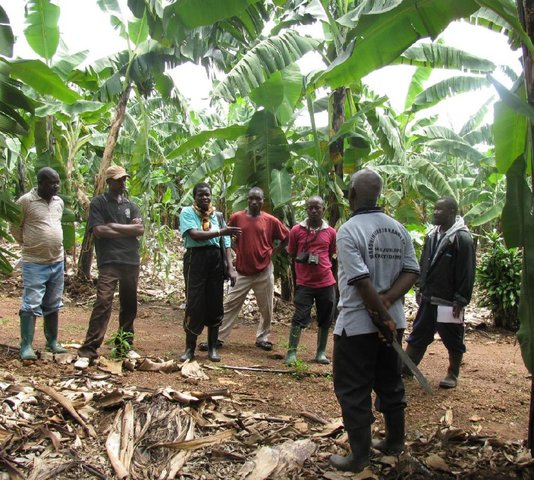
Integrated farm knowledge adoption [تنزانيا، جمهورية تنزانيا المتحدة]
The way and means through which a performing farmers adopt and use a combination of indigenous and scientific to maximaze production.
- جامع المعلومات: Jasson Rwazo
2. وصف تقنيةالإدارة المستدامي للأراضي
2.1 وصف مختصر للتقنية
تعريف التقنية:
This is a traditional banana and coffee complex cropping system interplanted with annual crops, trees,shrubs, vegetables and other diverse plants of social economic importance.
2.2 وصف تفصيلي للتقنية
الوصف:
Improved traditional multi-cropping system that combines banana and coffee as main crops planted in a specific spacing to optimize plant stands. Banana and coffee are intercropped with; 1. annuals crops: Maize, beans, yams, coco-yams;2. Vegetables: Lycoperscum esculentum, Amaranthus spp, Cucumis communis and Solanum aethopium ;3. Shrubs of social economic value. Trees (e.g Maesopsis eminii, Makhcamia lutea, Ricinus comunis, Ficus thorninghii) and shrubs (Dracaena usambarensis) are planted on the farm edge. These serve as live fence, wind breaker, source of timber, fuel wood, medicine and protect the field against erosion. To optimize farm production, application of 15cm thick mulch ( grass mulch and banana prunnings), farmyard or compost manure and interplanting with soil fertility and/or soil moisture improvement trees are ensured. With problems of climate change, water harvesting ditches and trenches are constructed. Water harvesting ditches are constructed to collect water from micro catchments like roads or homestead. Sustainability of the Improved Kibanja system has always been assured through crop/livestock integration approaches.The cropping system is typical in high rainfall areas along foot slopes, valley bottoms or hilltops preferably on fertile and deep soils.
Purpose of the Technology: The purpose is improve soil fertility,moisture, controlling soil erosion (wind and water) and suppressing weeds in order to improve the production banana, coffee and other inter planted crops.
Establishment / maintenance activities and inputs: Establishment activities: 1. Land clearing and preparation: Slashing, uprooting tree stumps, ploughing and pitting 60cm x 90cm banana hole and 60cm x 60cm coffee (Mid June to August) using simple farm implements; 2.Farm Yard Manure application: 60 Kg per banana holes and 36 Kg per coffee hole (August to early September); 2. Planting: 308 banana suckers at 3.6m x 8m spacing, 830 coffee seedlings at 3m x 8m spacing in alternating row, edge row trees seedling at 10m spacing and 15cm spacing for shrubs e.g. Dracaena usambarensis (September to November);4. Excavation of water retention structure ( after planting mainly in Novermber). Full establishment of Improved Kibanja cropping system can be attained in three years.
Maintenance activities:1. Weeding:Done two times per year (mid January to February / July to augost) before planting annual crops; 2.FYM enrichment: Every after 3 years; iii. banana dethrashing and desuckering ,topping mulch, coffee pruning and harvesting (Immediately after weeding); 4. Other maintenence activities: Disease control (nematode, banana weevils, Banana Xanthamonas Wilt) and Propping (using pole to support banana plant with heavy bunches against wind); 5.Inputs: Labour, farmyard manure, propping poles, mulch; 6. Simple farm implements:Hand hoe,machete and wheel barrow.
Natural / human environment: The technology is implemented in mixed land use type under sub humid condition receiving 1000-1500mm of rains per year. A combination of soil and water improvement measures (FYM application, Mulching, water retention ditches and live fencing) complement each other to minimize risk of crop failure and hence improve production. The slope is gentle to moderate , soil depth is moderate and soil texture loam. Simple hand tools are traditional used,Land ownership is individual not titled. Application of this technology determined by high establishment and maintenence cost.
2.3 صور التقنية
2.5 البلد/المنطقة/المواقع التي تم تنفيذ التقنية فيها والتي يغطيها هذا التقييم
البلد:
تنزانيا، جمهورية تنزانيا المتحدة
المنطقة/الولاية/المحافظة:
Tanzania
مزيد من التفاصيل حول الموقع:
Missenyi District, Kyazi Village
Map
×2.6 تاريخ التنفيذ
في حالة عدم معرفة السنة بالتحديد، يرجى الإشارة إلى التاريخ التقريبي:
- منذ أقل من 10 سنوات (مؤخرًا)
2.7 إدخال التقنية
حدد كيف تم إدخال التقنية:
- من خلال المشاريع/ التدخلات الخارجية
التعليقات (نوع المشروع، الخ):
Improved traditional land use system: The use of combination of measures in Improved Kibanja Cropping system in Kagera has been existing for more than 100 year ago.
3. تصنيف تقنية الإدارة المستدامي للأراضي
3.1 الغرض الرئيسي ( الأغراض الرئيسية) للتقنية
- تحسين الإنتاج
- الحد من تدهور الأراضي ومنعه وعكسه
- improve soil fertility
3.2 نوع (أنواع) استخدام الأراضي الحالية حيث يتم تطبيق التقنية

مختلطة (محاصيل/ رعي/ أشجار)، بما في ذلك الحراجة الزراعية
- الرعي الزراعي الحرجي
المنتجات / الخدمات الرئيسية:
Ficus thoninji,Markhamia lutea,Maesopesis eminii
major cash crop: Beans, banana and avocado
major food crop: Beans and banana
التعليقات:
Major land use problems (compiler’s opinion): Soil nutrient loss, decline of soil moisture and soil erosion by wind and fast water runoff.
Major land use problems (land users’ perception): Reduced crop production, loss of indigenous medicinal plants, reduced water water quatity in natural water sources.
Type of cropping system and major crops comments: Due to mixed farming and agroforestry there is high nutrient cycling resulting in high productivity
3.3 مزيد من المعلومات حول استخدام الأراضي
إمدادات المياه للأرض التي يتم تنفيذ التقنية عليها:
- بعلية
عدد مواسم الزراعة في السنة:
- 2
حدد:
Longest growing period in days: 120; Longest growing period from month to month: Short rains (September to December); Second longest growing period in days: 65; Second longest growing period from month to month: Long rains (March to June)
كثافة الثروة الحيوانية (إذا كانت ذات صلة):
1-10 LU /km2
3.4 مجموعةالإدارة المستدامة للأراضي التي تنتمي إليها هذه التقنية
- الحراجة الزراعية
- مصد الريح/حزام حماية
- حصاد المياه
3.5 انتشار التقنية
حدد انتشار التقنية:
- منتشرة بالتساوي على مساحة
إذا كانت التقنية منتشرة بالتساوي على منطقة ما، فحدد المنطقة التقريبية المغطاة:
- < 0.1 كم2 (10 هكتار)
التعليقات:
Total area covered by the SLM Technology is 0.062 km2.
2ha approximately
3.6 التدابير التقنية في مجال إلادارة المستدامة للأراضي

التدابير الزراعية
- A2: المادة العضوية/خصوبة التربة

التدابير النباتية
- V1: غطاء من الأشجار والشجيرات
- V2: الأعشاب والنباتات العشبية المعمرة

التدابير البنيوية
- S4: تسوية الخنادق والحفر

التدابير الإدارية
- M3: التخطيط وفقا للبيئة الطبيعية والبشرية
التعليقات:
Secondary measures: management measures
Type of agronomic measures: mixed cropping / intercropping, retaining more vegetation cover, mulching, manure / compost / residues, minimum tillage, pits
Type of vegetative measures: aligned: -against wind, aligned: -along boundary, aligned: -linear
3.7 الأنواع الرئيسية من تدهور الأراضي التي تناولتها التقنية

تآكل التربة بالمياه
- الوزن(Wt): فقدان التربة السطحية/تآكل السطح

التدهور الكيميائي للتربة
- (Cn): تراجع الخصوبة وانخفاض محتوى المادة العضوية (غير ناتج عن الانجراف)

التدهور البيولوجي
- (Bc): تناقص الغطاء النباتي
التعليقات:
Main causes of degradation: soil management (Cultivation along the slope and overcultivation), crop management (annual, perennial, tree/shrub) (Cultivation of season crop without reprenishing of soil nutrients), change of seasonal rainfall (Fractuation in rain season), droughts, population pressure, education, access to knowledge and support services
Secondary causes of degradation: Heavy / extreme rainfall (intensity/amounts), land tenure, poverty / wealth, inputs and infrastructure: (roads, markets, distribution of water points, other, …)
3.8 منع أو حد أو عكس تدهور الأراضي
تحديد هدف التقنية فيما يتعلق بتدهور الأراضي:
- منع تدهور الأراضي
- الحد من تدهور الأراضي
التعليقات:
Secondary goals: mitigation / reduction of land degradation
4. المواصفات الفنية، وأنشطة التنفيذ، والمدخلات، والتكاليف
4.1 الرسم الفني للتقنية
المؤلف:
Jasson Rwazo, P.O.BOX 38 Misseny Tanzania, rjrwazo@gmail.com
4.2 المواصفات الفنية/شروحات الرسم الفني
Location: Kyazi Village. Missenyi District, Kagera Region, Tanzania
Date: 2012.08.28
Technical knowledge required for field staff / advisors: moderate (The technology requires moderate technical knowledge for adoption)
Technical knowledge required for land users: moderate (The technology requires moderate technical knowledge for adoption)
Main technical functions: control of raindrop splash, control of dispersed runoff: retain / trap, control of concentrated runoff: retain / trap, improvement of ground cover, increase in organic matter
Secondary technical functions: increase in nutrient availability (supply, recycling,…), increase of infiltration, water harvesting / increase water supply, reduction in wind speed, increase of biomass (quantity)
Mixed cropping / intercropping
Material/ species: Banana
Quantity/ density: 304
Remarks: 3.6 m by 8m
Retaining more vegetation cover
Material/ species: Beans
Remarks: Random
Mulching
Material/ species: Grass mulch, banana(Prooning) trashes mulch
Quantity/ density: 10000
Remarks: Spreading the mulch
Material/ species: Coffee
Quantity/ density: 830
Remarks: 3m by 8m
Manure / compost / residues
Material/ species: Farmyard manure, farm residure,
Quantity/ density: 40 tone
Remarks: Spreading on the pit
Minimum tillage
Material/ species: Hand hoe,matechette
Pits
Material/ species: Hand hoe,matechette
Aligned: -against wind
Vegetative material: T : trees / shrubs
Number of plants per (ha): 277
Vertical interval between rows / strips / blocks (m): Random
Spacing between rows / strips / blocks (m): Random
Vertical interval within rows / strips / blocks (m): Random
Width within rows / strips / blocks (m): 6
Aligned: -along boundary
Vegetative material: T : trees / shrubs
Number of plants per (ha): 100000
Vertical interval between rows / strips / blocks (m): 0.01
Width within rows / strips / blocks (m): 0.01
Aligned: -linear
Vegetative material: T : trees / shrubs
Number of plants per (ha): 100000
Vertical interval between rows / strips / blocks (m): 0.01
Width within rows / strips / blocks (m): 0.01
Trees/ shrubs species: Maeesopsis Eminii, Dracaena usambalensis,Erythrina abysinica
Fruit trees / shrubs species: Pawpaw, Orange, Avocado
Perennial crops species: Banana, Coffee, Vanilla
Other species: Carisa edulis (shrubs)
Slope (which determines the spacing indicated above): 6.3%
Gradient along the rows / strips: 6.3%
Diversion ditch/ drainage
Vertical interval between structures (m): 0.4
Spacing between structures (m): 6
Depth of ditches/pits/dams (m): 0.3
Width of ditches/pits/dams (m): 0.3
Length of ditches/pits/dams (m): 3
Height of bunds/banks/others (m): 0.15
Width of bunds/banks/others (m): 0.15
Length of bunds/banks/others (m): 3
Waterway
Vertical interval between structures (m): 0.4
Spacing between structures (m): 6
Depth of ditches/pits/dams (m): 0.75
Width of ditches/pits/dams (m): 1.5
Length of ditches/pits/dams (m): 2
Height of bunds/banks/others (m): 0.3
Width of bunds/banks/others (m): 0.4
Length of bunds/banks/others (m): 5
Retention/infiltration ditch/pit, sediment/sand trap
Vertical interval between structures (m): 0.4
Spacing between structures (m): 6
Depth of ditches/pits/dams (m): 0.75
Width of ditches/pits/dams (m): 1.5
Length of ditches/pits/dams (m): 2
Height of bunds/banks/others (m): 0.3
Width of bunds/banks/others (m): 0.4
Length of bunds/banks/others (m): 5
Construction material (earth): 2.25 m3 of earth material used per ditch
Slope (which determines the spacing indicated above): 6%
Lateral gradient along the structure: 8%
Specification of dams/ pans/ ponds: Capacity 10m3
Catchment area: 1.6Ham2
For water harvesting: the ratio between the area where the harvested water is applied and the total area from which water is collected is: 1:3.5
4.3 معلومات عامة بخصوص حساب المدخلات والتكاليف
حدد العملة المستخدمة لحساب التكاليف:
- دولار أمريكي
اذكر متوسط تكلفة أجر العمالة المستأجرة في اليوم الواحد:
1
4.4 أنشطة التأسيس
| النشاط | نوع التدبير | التوقيت | |
|---|---|---|---|
| 1. | Land clearing and preparation:Slashing,uprooting tree stumps, ploughing and pitting | June to August | |
| 2. | Availing and applying 54 tone Farm Yard | August to early September | |
| 3. | Planting: 308 banana suckers 830 coffee and tree edge low tree seedlings | From September | |
| 4. | Construction of water harvesting ditches | بنيوية أو هيكلية | Once year |
4.5 التكاليف والمدخلات اللازمة للتأسيس
| تحديد المدخلات | الوحدة | الكمية | التكاليف لكل وحدة | إجمالي التكاليف لكل مدخل | % من التكاليف التي يتحملها مستخدمو الأراضي | |
|---|---|---|---|---|---|---|
| العمالة | Land clearing | persons/day | 202,0 | 1,18316 | 239,0 | 100,0 |
| العمالة | Construction of water harvesting ditches | persons/day | 4,0 | 0,937 | 3,75 | 100,0 |
| معدات | Tools | ha | 1,0 | 61,56 | 61,56 | 100,0 |
| المواد النباتية | Seedlings | pieces | 1138,0 | 0,0468 | 53,26 | 100,0 |
| الأسمدة والمبيدات الحيوية | Manure | tons | 54,0 | 34,7222 | 1875,0 | |
| غير ذلك | Cuttings | ha | 1,0 | 2234,6 | 2234,6 | 100,0 |
| إجمالي تكاليف إنشاء التقنية | 4467,17 | |||||
التعليقات:
Duration of establishment phase: 36 month(s)
4.6 الصيانة/الأنشطة المتكررة
| النشاط | نوع التدبير | التوقيت/الوتيرة | |
|---|---|---|---|
| 1. | Topping grass mulch | زراعية | 3 times per year |
| 2. | Farm yard manure enrichment | زراعية | 2 times per year |
| 3. | Removal of sediments and debris in water retention ditches. | زراعية | Every year |
| 4. | To replacement propping Poles | زراعية | Every 1.5 year |
| 5. | To corve transportation cost | زراعية | Manure |
| 6. | Replacement of propping pole and live hedges | نباتية | Every 1.5 year |
| 7. | Removal of sediments and debris in water retention ditches | بنيوية أو هيكلية | Once per year |
4.7 التكاليف والمدخلات اللازمة للصيانة/للأنشطة المتكررة (سنويًا)
| تحديد المدخلات | الوحدة | الكمية | التكاليف لكل وحدة | إجمالي التكاليف لكل مدخل | % من التكاليف التي يتحملها مستخدمو الأراضي | |
|---|---|---|---|---|---|---|
| العمالة | Topping grass mulch | persons/day | 10,0 | 4,101 | 41,01 | 100,0 |
| العمالة | Applying FYM | persons/day | 10,0 | 3,906 | 39,06 | 100,0 |
| العمالة | Removal of sediments | persons/day | 4,0 | 0,9375 | 3,75 | 100,0 |
| العمالة | To replacement propping Poles | persons/day/ha | 10,0 | 3,906 | 39,06 | 100,0 |
| معدات | Tools | per ha | 4,0 | 1,875 | 7,5 | 100,0 |
| الأسمدة والمبيدات الحيوية | Farm yard manure | tons | 20,833 | 46,8 | 974,98 | 100,0 |
| مواد البناء | Wood | pieces/ha | 600,0 | 0,625 | 375,0 | 100,0 |
| غير ذلك | Mulching material | bundle | 300,0 | 1,875 | 562,5 | 100,0 |
| غير ذلك | Transportation | trips | 19,0 | 61,673 | 1171,79 | 100,0 |
| إجمالي تكاليف صيانة التقنية | 3214,65 | |||||
التعليقات:
Machinery/ tools: Machetes, Mattocks, Hand hoe, spade, wheel barrow, Machete,Hand hoes, spade, Hand hoe,Machete, Spade
Cost assesment completed in June 2012
4.8 أهم العوامل المؤثرة على التكاليف
قدم وصفا لأهم العوامل التي تؤثر على التكاليف:
Manure is most determinate factor high transportation cost especially during establishment
5. البيئة الطبيعية والبشرية
5.1 المناخ
هطول الأمطار السنوي
- < 250 مم
- 251- 500 ملم
- 501 - 750ملم
- 1,000-751 ملم
- 1,500-1,100 ملم
- 2,000-1,500 ملم
- 3,000-2,001 ملم
- 4,000-3,100 ملم
- > 4000 ملم
المواصفات/التعليقات على هطول الأمطار:
Avarage rainfall 1200mm, Bimode rainfall, 5 month dry season
المنطقة المناخية الزراعية
- شبه رطبة
Thermal climate class: tropics. Annual temperature 23C
Length of growing period 120 -300 days
5.2 طوبوغرافيا
متوسط الانحدارات:
- مسطح (0-2%)
- بسيط (3-5%)
- معتدل (6-10%)
- متدحرج (11-15%)
- تلال (16-30%)
- شديدة الانحدار(31-60%)
- فائقة الانحدار (>60%)
التضاريس:
- هضاب/سهول
- أثلام مرتفعة
- المنحدرات الجبلية
- منحدرات التلال
- منحدرات في السفوح
- قاع الوادي
المنطقة الارتفاعية:
- 100-0 متر فوق سطح البحر
- 500-101 متر فوق سطح البحر
- 1,000-501 متر فوق سطح البحر
- 1,500-1,001 متر فوق سطح البحر
- 2,000-1,501 متر فوق سطح البحر
- 2,500-2,100 متر فوق سطح البحر
- 3,000-2,501 متر فوق سطح البحر
- 4,000-3,001 متر فوق سطح البحر
- > 4000 متر فوق سطح البحر
وضح ما إذا كانت التقنية مطبقة على وجه التحديد في:
- حالات مقعرة
التعليقات والمواصفات الإضافية بشأن التضاريس:
Altitudinal zonation: 1270m a.s.l
Slopes on average: Movement of soil due to erosion, exposure of parent rock on some part of the farm
5.3 التربة
متوسط عمق التربة:
- ضحل جدًا (0-20 سم)
- ضحلة (21-50 سم)
- متوسطة العمق (51-80 سم)
- عميقة (81-120 سم)
- عميقة جدًا (> 120 سم)
قوام التربة (التربة السطحية):
- متوسط ( طميي، سلتي)
المواد العضوية في التربة السطحية:
- متوسطة (1-3%)
إذا كان متاحًا، قم بإرفاق وصف كامل للتربة أو تحديد المعلومات المتوفرة، على سبيل المثال نوع التربة، الرقم الهيدروجيني/ درجة حموضة التربة، قدرة التبادل الكاتيوني، النيتروجين، الملوحة وما إلى ذلك.
Soil depth on average: Shallow on the hill slope and moderately deep on the valley bottom, also deep sometimes
Soil texture (topsoil): Sandy loam
Topsoil organic matter: Due to the high use of organic manure (farm yard manure) and mulch
Soil fertility is medium
Soil drainage / infiltration is medium due to the high use of organic manure (farm yard manure), mulch, good aeration
Soil water storage capacity is medium due to the high use of organic manure (farm yard manure) and mulch
5.4 توافر المياه ونوعيتها
منسوب المياه الجوفية:
> 50 م
توافر المياه السطحية:
متوسط
نوعية المياه (غير المعالجة):
مياه الشرب سيئة (تتطلب معالجة)
5.5 التنوع البيولوجي
تنوع الأنواع:
- متوسط
التعليقات والمواصفات الإضافية بشأن التنوع البيولوجي:
Different species of soil micro organisms and plant species
5.6 خصائص مستخدمي الأراضي الذين يطبقون التقنية
التوجه السوقي لنظام الإنتاج:
- مختلط (كفاف/ تجاري)
الدخل من خارج المزرعة:
- أقل من % 10من كامل الدخل
المستوى النسبي للثروة:
- متوسط
أفراداً أو مجموعات:
- فرد/أسرة معيشية
مستوى المكننة:
- عمل يدوي
الجنس:
- نساء
- رجال
اذكر الخصائص الأخرى ذات الصلة لمستخدمي الأراضي:
Land users applying the Technology are mainly common / average land users
Difference in the involvement of women and men: The land inheritance is mainly dominated by male, women mostly use the land for production of understory crops such as beans; banana and coffee production is dominated by men
Population density: > 500 persons/km2
Annual population growth: 2% - 3%; 3%
5% of the land users are very rich and own 30% of the land (Own 2.5-5 acre land, car, 10-20 catlle,brick wall house).
15% of the land users are rich and own 20% of the land (Own 1-2.5 acre of land,2-5 cattle, brick wall house).
60% of the land users are average wealthy and own 35% of the land (Own 0.5-1 acre of land,2-3 goats,mud wall house with corrugarated iron roof).
15% of the land users are poor and own 10% of the land (Own 0-0.5 acre of land, no livestock, mud house withgrass roofing).
5% of the land users are poor and own 5% of the land (Does not own land or own less than 0.5 acre of land, work as casual labour).
Off-farm income specification: 90% of land users income depends on on- income
Market orientation of production system: Mainly for substence for commecial
Level of mechanization: Using hand tools
5.7 متوسط مساحة الأرض المملوكة أو المستأجرة من قبل مستخدمي الأراضي الذين يطبقون التقنية
- < 0.5 هكتارا
- 0.5 - 1 هكتار
- 1 -2 هكتار
- 2 - 5 هكتار
- 5 - 15 هكتار
- 15 - 50 هكتار
- 50 - 100هكتار
- 500-100 هكتار
- 1,000-500 هكتار
- 10,000-1,000 هكتار
- > 10,000 هكتار
5.8 ملكية الأراضي، وحقوق استخدام الأراضي، وحقوق استخدام المياه
ملكية الارض:
- فردية، لا يوجد سند ملكية
5.9 الوصول إلى الخدمات والبنية التحتية
الصحة:
- ضعيف
- معتدل
- جيد
التعليم:
- ضعيف
- معتدل
- جيد
المساعدة التقنية:
- ضعيف
- معتدل
- جيد
العمل (على سبيل المثال خارج المزرعة):
- ضعيف
- معتدل
- جيد
الأسواق:
- ضعيف
- معتدل
- جيد
الطاقة:
- ضعيف
- معتدل
- جيد
الطرق والنقل:
- ضعيف
- معتدل
- جيد
مياه الشرب وخدمات الصرف الصحي:
- ضعيف
- معتدل
- جيد
الخدمات المالية:
- ضعيف
- معتدل
- جيد
6. الآثار والتصريحات الختامية
6.1 الآثار التي أظهرتها التقنية في الموقع
الآثار الاجتماعية والاقتصادية
الإنتاج
إنتاج المحاصيل
الكمية قبل الإدارة المستدامة للأراضي:
50
الكمية بعد الإدارة المستدامة للأراضي:
300
التعليقات/ حدد:
Bunch of banana with 70 kg each
خطر فشل الإنتاج
تنوع المنتج
التعليقات/ حدد:
Depend mainly on banana sell
إدارة الأراضي
الدخل والتكاليف
النفقات على المدخلات الزراعية
الكمية قبل الإدارة المستدامة للأراضي:
1875 $
الكمية بعد الإدارة المستدامة للأراضي:
1406 $
دخل المزرعة
الكمية قبل الإدارة المستدامة للأراضي:
6250
الكمية بعد الإدارة المستدامة للأراضي:
25000
التعليقات/ حدد:
Annual income in dollar
تنوع مصادر الدخل
التعليقات/ حدد:
Solery depend on farm
عبء العمل
التعليقات/ حدد:
Reduced weeding, but technology is labour intensive.
الآثار الاجتماعية والثقافية
الأمن الغذائي / الاكتفاء الذاتي
الكمية قبل الإدارة المستدامة للأراضي:
1000
الكمية بعد الإدارة المستدامة للأراضي:
4000
التعليقات/ حدد:
Increase in bunch of banana produde annually
الوضع الصحي
الكمية قبل الإدارة المستدامة للأراضي:
5
الكمية بعد الإدارة المستدامة للأراضي:
2
التعليقات/ حدد:
Frequency of attedndence to hospital due to edequate food supply
الفرص الترفيهية
المعرفة بالإدارة المستدامة للأراضي/تدهور الأراضي
التعليقات/ حدد:
Adoption by neighbouring farmers
الآثار الايكولوجية
دورة المياه / الجريان السطحي
حصاد / جمع المياه
الكمية قبل الإدارة المستدامة للأراضي:
0
الكمية بعد الإدارة المستدامة للأراضي:
10
التعليقات/ حدد:
Due to water harvesting dithchers along the foot path in the farm
الجريان السطحي
التعليقات/ حدد:
Due to the use of mulch and corver crops
التبخر
التعليقات/ حدد:
Due to corver crop and mulch
التربة
رطوبة التربة
التعليقات/ حدد:
Use of banana trash mulch and other corver crops
غطاء التربة
دورة المغذيات/إعادة الشحن
التنوع البيولوجي: الغطاء النباتي، الحيوانات
الكتلة الحيوية/ طبقة الكربون فوق التربة
الحد من مخاطر المناخ والكوارث
انبعاث الكربون والغازات المسببة للاحتباس الحراري
خطر الحريق
التعليقات/ حدد:
Due to mulching material
سرعة الرياح
6.2 الآثار التي أظهرتها التقنية خارج الموقع
توافر المياه
الأضرار التي لحقت بحقول الجيران
6.3 تعرض التقنية وحساسيتها لتغير المناخ التدريجي والظواهر المتطرفة/الكوارث المرتبطة بالمناخ (كما يراها مستخدمو الأراضي)
تغير مناخ تدريجي
تغير مناخ تدريجي
| الموسم | نوع التغير المناخي/ المتطرف | كيف تتعامل التقنية مع ذلك؟ | |
|---|---|---|---|
| درجة الحرارة السنوية | زيادة | جيدا |
الظواهر المتطرفة / الكوارث المرتبطة بالمناخ
الكوارث الجوية
| كيف تتعامل التقنية مع ذلك؟ | |
|---|---|
| عاصفة ممطرة محلية | جيدا |
| عاصفة هوائية محلية | جيدا |
الكوارث المناخية
| كيف تتعامل التقنية مع ذلك؟ | |
|---|---|
| جفاف | جيدا |
الكوارث الهيدرولوجية
| كيف تتعامل التقنية مع ذلك؟ | |
|---|---|
| فيضان عام (نهر) | ليس جيدا |
العواقب الأخرى المتعلقة بالمناخ
العواقب الأخرى المتعلقة بالمناخ
| كيف تتعامل التقنية مع ذلك؟ | |
|---|---|
| انخفاض فترة النمو | جيدا |
التعليقات:
Use drainage trenches
6.4 تحليل التكلفة والعائد
كيف يمكن مقارنة العوائد نسبة لتكاليف الإنشاء (من وجهة نظر مستخدمي الأراضي)؟
عوائد قصيرة الأجل:
إيجابي قليلا
عوائد طويلة الأجل:
ايجابي جدا
كيف تتم مقارنة العوائدمع كلفة الصيانة/التكاليف المتكررة (من وجهة نظر مستخدمي الأراضي)؟
عوائد قصيرة الأجل:
إيجابي
عوائد طويلة الأجل:
ايجابي جدا
التعليقات:
Depending on regular application of manure and mulch plus good management of the farm
6.5 اعتماد التقنية
- أكثر من 50%
إذا كان متاحًا، قم بتحديد الكمية (عدد الأسر المعيشية و/أو المساحةالمغطاة):
317 households (70 percent of all land users in the area)
من بين جميع الذين تبنوا التقنية، كم عدد الذين فعلوا ذلك بشكل تلقائي، أي دون تلقي أي حوافز مادية/مدفوعات؟:
- 100-90%
التعليقات:
317 land user families have adopted the Technology without any external material support
There is a moderate trend towards spontaneous adoption of the Technology
Comments on adoption trend: Limited with high labour and input cost (Manure)
6.7 نقاط القوة / المزايا / الفرص التي توفرها التقنية
| نقاط القوة/ المزايا/ الفرص من وجهة نظر مستخدمي الأراضي |
|---|
|
Increased house hold food security and income How can they be sustained / enhanced? Schedule regular maintenance activities |
| نقاط القوة/ المزايا/ الفرص من وجهة نظر جامع المعلومات أو غيره من الاشخاص الرئيسيين لمصدر المعلومات |
|---|
|
Soil moisture conservation How can they be sustained / enhanced? Maintenance of water harvesting ditches and replacement of mulching materials |
|
Soil fertility improvement How can they be sustained / enhanced? Regular application of manure and mulch |
|
Improvement of soil structure and aeration How can they be sustained / enhanced? Manure and mulch application |
|
Control of soil erosion How can they be sustained / enhanced? Maintenance of plant cover and water retention ditches, manure and mulch application |
6.8 نقاط ضعف / مساوىء / مخاطر التقنية وسبل التغلب عليها
| نقاط الضعف/ المساوىء/ المخاطر من وجهة نظر جامع المعلومات أو غيره من الاشخاص الرئيسيين لمصدر المعلومات | كيف يمكن التغلب عليها؟ |
|---|---|
| High labour and capital demand | Phase in implementation and regular maintenance of the technology |
| High risk of fire | Use of fire breaks |
7. المراجع والروابط
7.2 المراجع للمنشورات المتاحة
العنوان، المؤلف، السنة، النظام القياسي الدولي لترقيم الكتب ISBN:
Improving Productivity of Field Crops and Post Harvest Management in North west Tanzania,United Republic of Tanzania Ministry of Agriculture, Food and Cooperatives,2008
7.3 روابط للمعلومات ذات الصلة المتوفرة على الإنترنت
العنوان/الوصف:
Kagera TAMP project website
عنوان الرابط URL:
http://www.fao.org/nr/kagera/en/
الروابط والوحدات المواضيعية
توسيع الكل طي الكلالروابط

Integrated farm knowledge adoption [تنزانيا، جمهورية تنزانيا المتحدة]
The way and means through which a performing farmers adopt and use a combination of indigenous and scientific to maximaze production.
- جامع المعلومات: Jasson Rwazo
الوحدات المواضيعية
لا يوجد وحدات مواضيعية



